What if your salespeople could concentrate solely on selling, while every other task was handled by a dedicated support team? That’s exactly what implementing sales enablement is about. A strategy that reshapes how organizations approach the sales process. Instead of expecting sellers to be analysts, content creators, and product experts all at once, sales enablement equips them with ready-made tools and materials.
Sales enablement is primarily about making salespeople’s work easier and faster for them to achieve sales targets.
The following text addresses three questions:
1. When can implementing sales enablement pay off the most for a company?
2. In what areas can sales enablement be implemented and what specifically can it do?
3. Finally, some practical advice on how to implement sales enablement in your company.
Let’s move on to part one.
Visual content’s role in sales enablement success
Before diving into implementation strategies, it’s essential to understand how visual content transforms sales enablement efforts.
When you think about implementing sales enablement, visual content isn’t just a nice-to-have addition. It’s become essential for teams that want to see real results. Here’s why! While sales reps are great at explaining complex products verbally, they often find themselves repeating the same explanations dozens of times per week. Visual content changes this dynamic entirely.
Visual sales enablement content serves multiple purposes in empowering sales teams:
Training materials that actually stick with people long after the session ends.
Product demonstrations that make complex features click for prospects instantly.
Sales reps who can focus on relationship building instead of basic education.
Faster decision-making from prospects who can visualize solutions clearly.
Sales enablement strategy – How does it work in practice?
Let’s look at Robert Lewandowski. We all know that he’s absolutely at the top (just like Iga Świątek, who conquered Wimbledon). So he’s probably a good example 😃.
Before the FC Barcelona star steps out onto the pitch, a lot of preparation work needs to be done. His matchday outfit must be clean and ironed, his team mates and opponents must be ready, and the coach with the team must arrive at the venue.
Of course, Robert doesn’t wash the jersey himself, he doesn’t do statistical analyses of the opponents’ weak points and he certainly doesn’t drive the club bus.
He has a whole staff of people from administration, coaches, physiotherapists and analysts behind him so that he can focus on the game of football.
And what about the salespeople?
They are often the ones who search for potential customers, analyze their situation, make appointments, conduct meetings and work out the details of the contract.
Because of this, salespeople are less productive than they could be.
Just as a football player won’t reach his full potential if he’s a washerwoman, match analyst and coach driver, a salesperson won’t make as many sales calls as he could if he’s a pre-sales person, sales analyst and blogger.
With sales enablement, salespeople can – like football players – have a staff that allows them to focus on the most important task: selling.
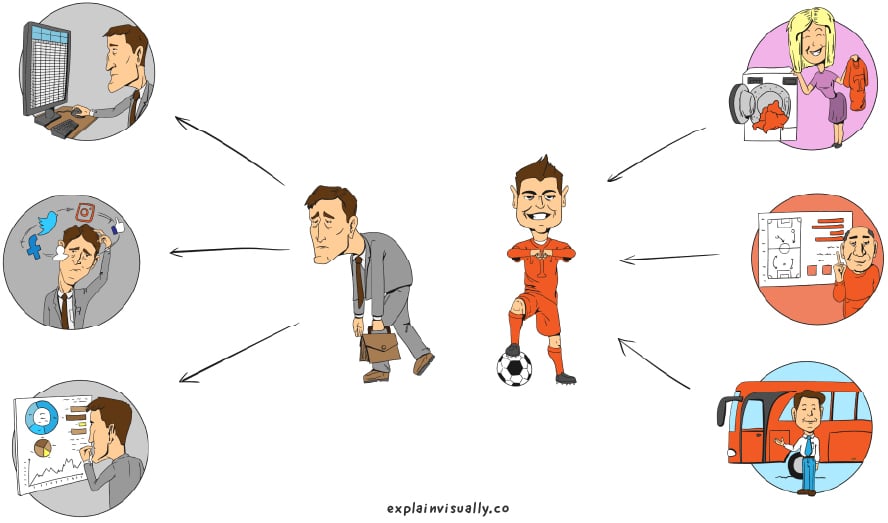
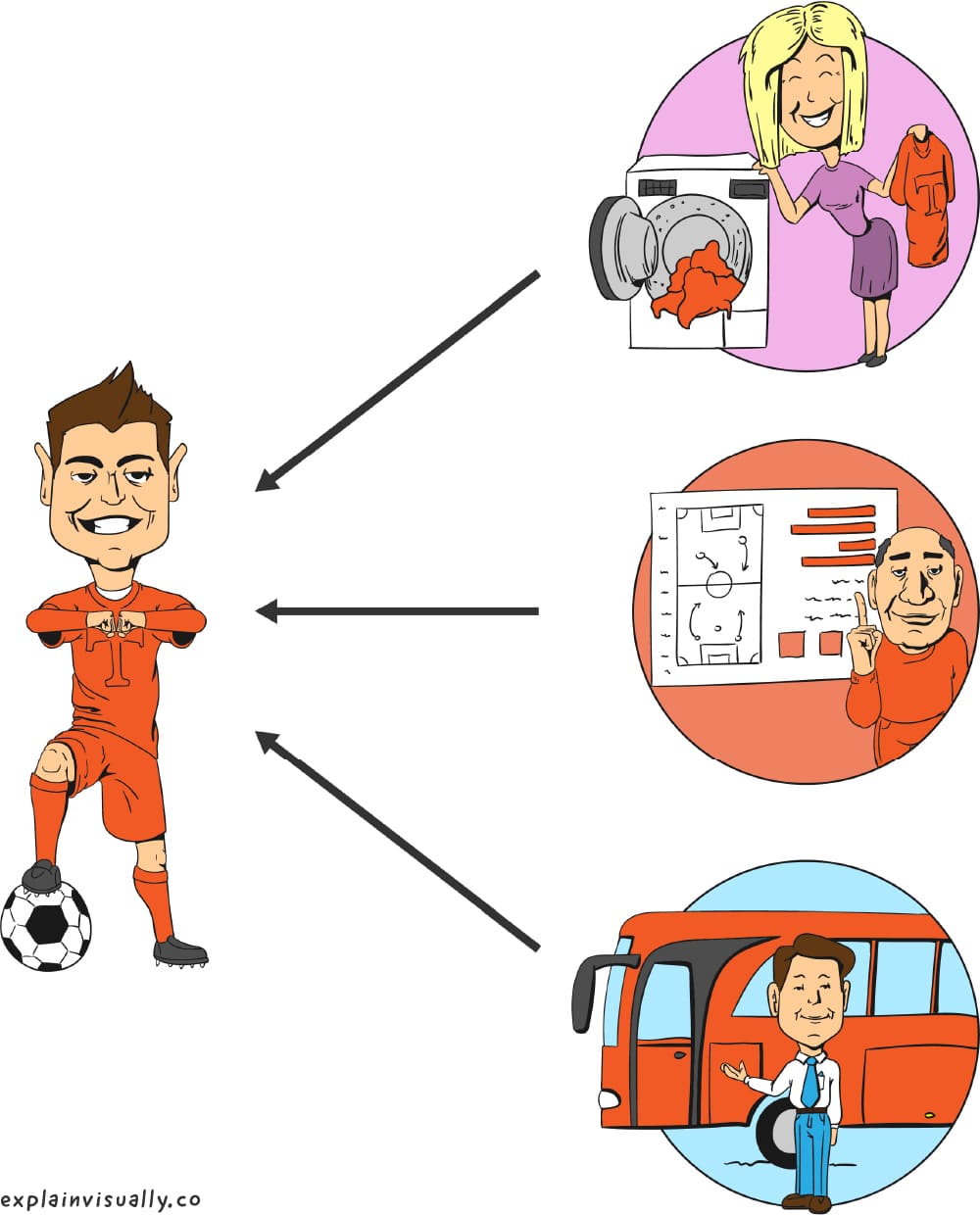
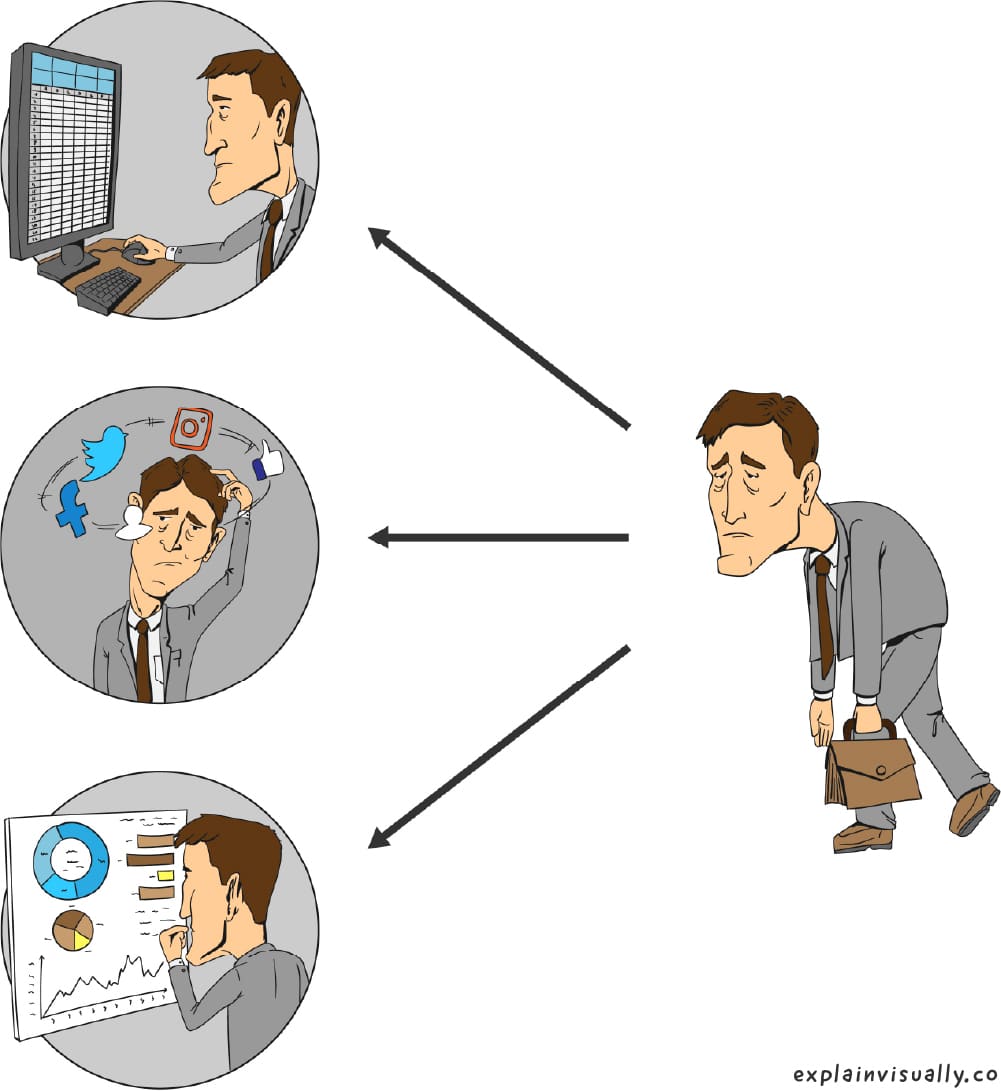
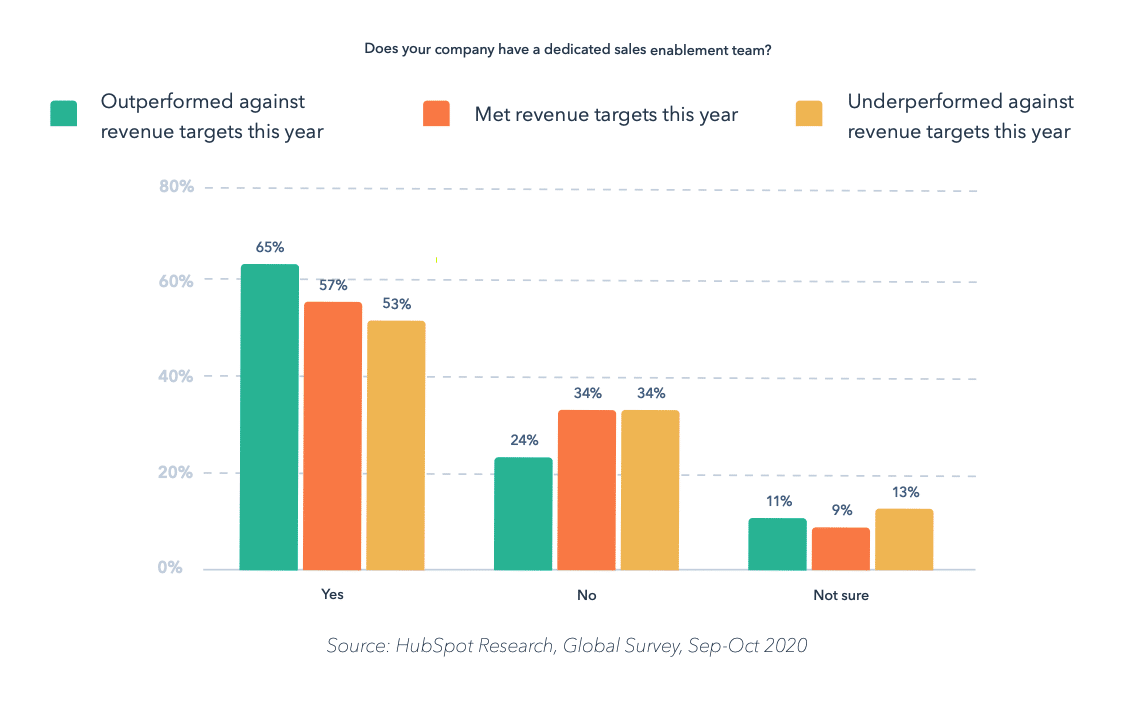
So in a nutshell, sales enablement is about equipping salespeople with everything they need to work:
- faster (shorter deal closing time);
- bigger (deal value);
- more effective (% of deals closed) selling.
The reality is straightforward! When sales teams have access to effective sales enablement tools, they consistently outperform those working without proper support. The benefits of sales enablement become immediately apparent when sales reps are empowered with the right knowledge and training. They’re more confident in their customer interactions and more successful at closing deals. This transformation happens because an effective sales enablement strategy addresses the fundamental challenges that hold back sales performance:
lack of product knowledge,
inconsistent messaging,
limited access to proven sales techniques.
When are companies most likely to consider sales enablement? – Triggers for implementing sales enablement
1) The company is dependent on one-star performer
This is a very uncomfortable situation for the company because such an employee can leave to a competitor, along with 40% of the customers.
In this situation, sales enablement helps reduce risk and levels the playing field between salespeople. This is done by standardizing sales through training, sales scripts, good sales presentations or explainer videos.
Of course, not every salesperson can become a star but most can start selling solidly.
Just like not everyone will become a second Lewandowski, but if they have the right coaching staff and good developmental conditions, they will develop faster than if they were playing in the backyard with their friends.

2) You need to recruit new salespeople and scale your sales department
Let’s assume that your annual turnover rate is 14%. That means that if you have a team of 15 people, you need to recruit two new employees per year.
Every day a salesperson is onboarded is a day they don’t sell so in practice onboarding can cost the company thousands.
Sales enablement helps to accelerate the onboarding and development of salespeople.
This is mainly due to the company having sales resources – the best practices, model sales conversations, content and tool manuals – collected in one place.
It is the same in soccer.
If a player comes to a club, there is always uncertainty about how the player will adapt. If the player’s introduction to the team is well organized, it increases the chances that the player will fit in.
This is especially useful when working remotely, when knowledge sharing between vendors is much less fluid.
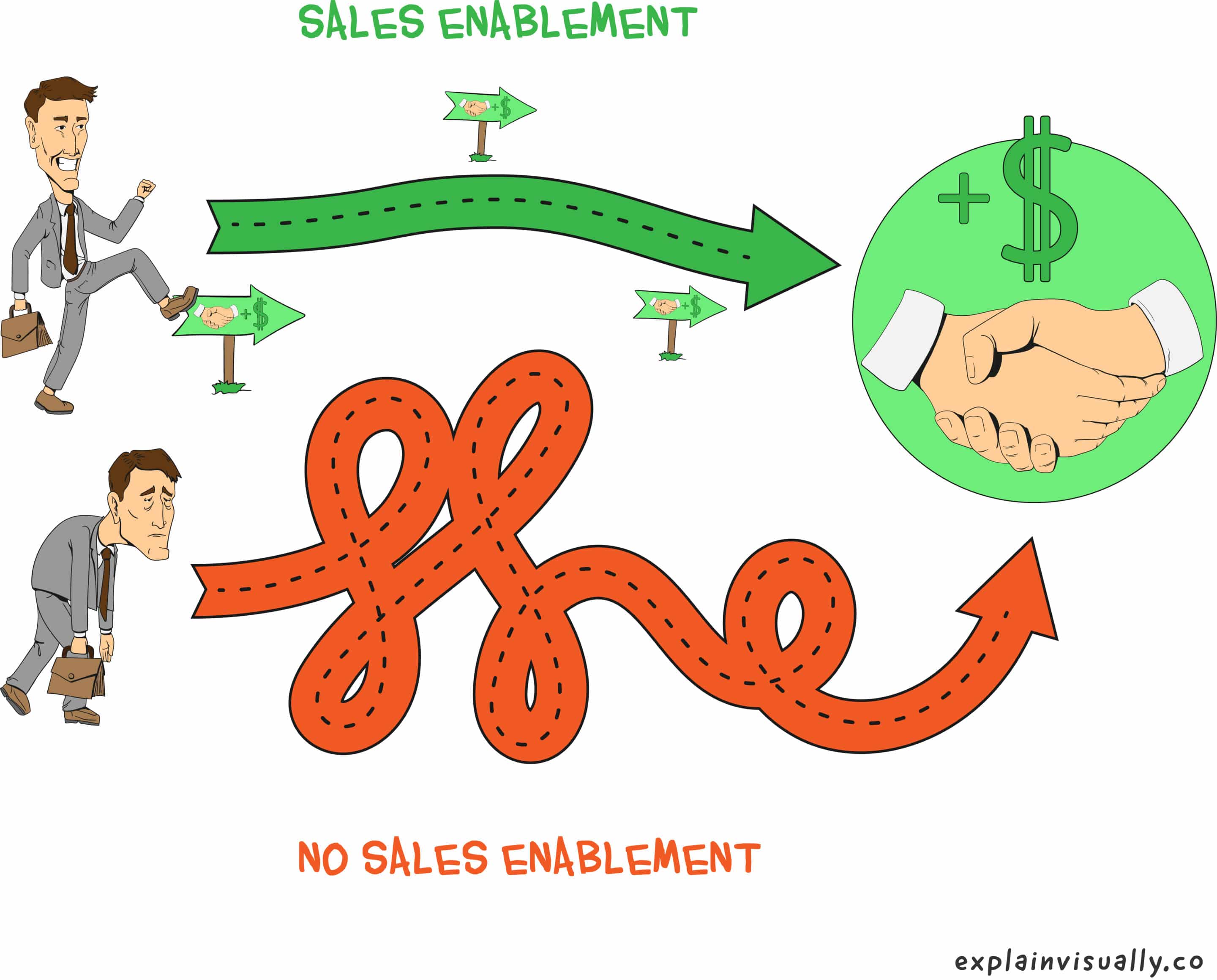
3) You don’t know if your marketing efforts are translating into sales
“What is marketing doing all day?” – thinks many a salesperson.
If you don’t know what they’re doing and you’re concerned that their activities may be disconnected from reality, consider involving the marketing staff in sales enablement.
This will ensure that the company is focusing on what drives results.You know what happens when marketing creates beautiful presentations that sales never uses?
Nothing 🤣.
And you know what happens when sales creates their own materials that look unprofessional?
Not much better😅.
The magic happens when both teams work together on visual sales enablement content. Marketing brings the creative skills and design expertise, while sales contributes the frontline knowledge about what customers actually need to hear. This collaboration produces visual materials that look professional and actually work in real sales situations throughout the customer journey.
So remember:
Marketing teams understand how to create engaging content, while sales teams know what customer interactions require. Together, they can develop visual materials that support the entire customer journey.
4) The company has a lot of sales materials and content, but it’s a mess
Five versions of a sales presentation on the company drive.
Dozens of scripts from sales training courses that nobody looks at.
A dozen or so blog articles that salespeople don’t use.
If this sounds familiar, sales enablement would help to clean up this mess and arrange materials and processes for better productivity.
Visual content management becomes especially important here. Unlike text-based documents that can be easily overlooked, well-designed visual sales materials stand out and are more likely to be used by sales professionals. Visual content increases sharing potential by 40%. It more likely that sales reps will actually utilize these resources in their customer interactions.
Here’s something every sales manager knows:
Explaining the same product features over and over gets old fast.
Your reps spend valuable selling time on basic education instead of building relationships and closing deals. Visual training materials change this dynamic completely. Explainer videos and animated presentations help information stick better in people’s minds. When sales reps have access to these visual resources, they can focus on what they do best: understanding customer needs and providing solutions. The consistency across your team improves too, since everyone’s working from the same visual playbook.
5) There is no synergy between marketing and sales departments
If a customer sees one thing in advertisements, then during a meeting a salesperson says something different, and in the offer receives something again, the customer may lose trust in the company.
And lack of trust delays or may kill the sale.
Therefore, message consistency often increases a company’s performance.
This, of course, requires marketing and sales to work together. When there is such cooperation, you can build a common sales narrative and prepare a set of clear rules for both departments to follow.
- What we say: i.e. how we tell about the offer, and how we don’t and why;
- What is the process: i.e. in what order do we unveil the next stage to guide the customer down the sales funnel;
- How we position our offering: i.e. how it relates to the competition.
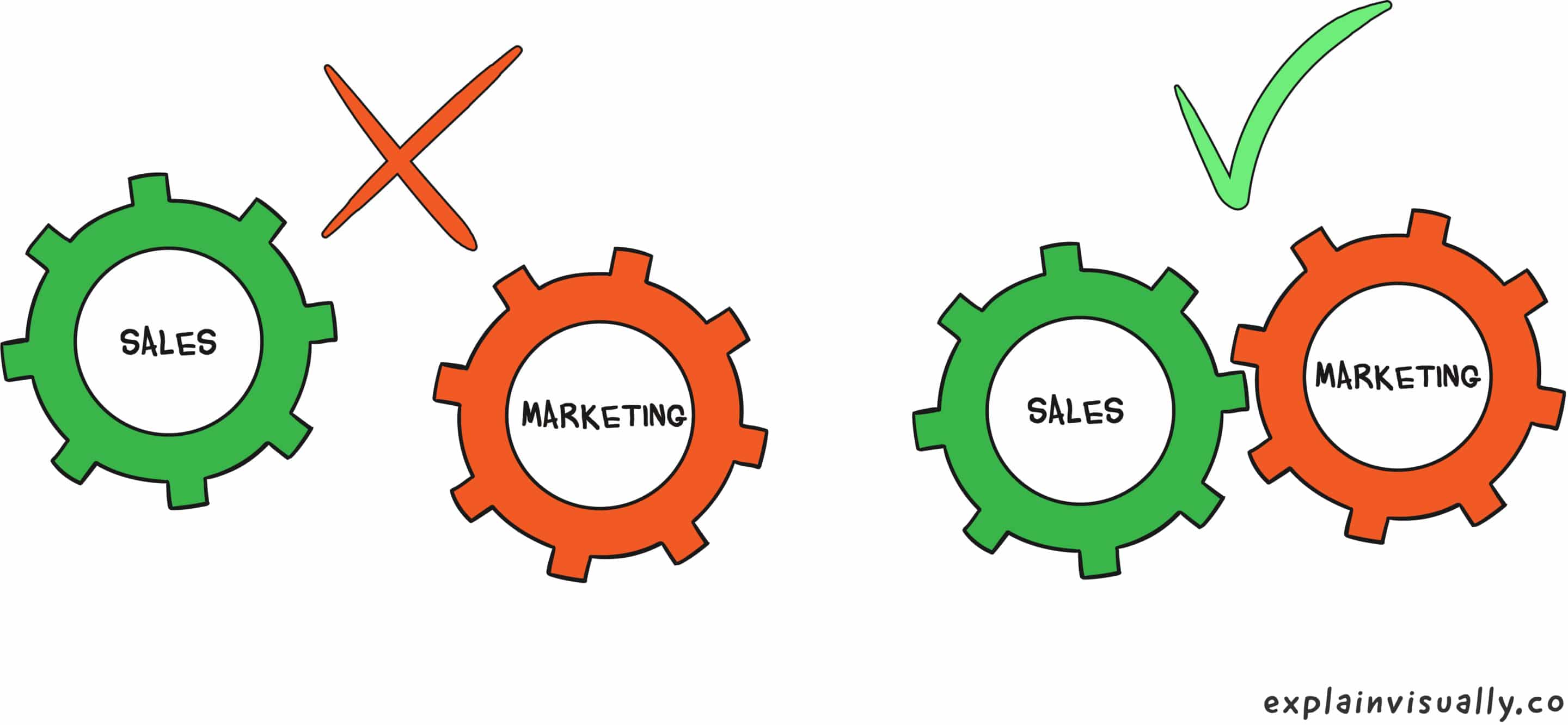
When the narrative is ready, you can base materials on it.
Examples of cold emails, cold call scripts, excerpts from ads, landing pages, and explainer videos can be developed by the company.
It is then easier for salespeople and marketers to translate abstract guidelines into concrete, everyday actions.
Of course, sales enablement does not have to be limited to these situations.
The entirety of sales enablement activities can be summed up in four areas. Then from each area, the company can choose what to implement and what not.
The four pillars of successful sales enablement strategy
The easiest way to think about sales enablement is in these four areas.
1) Gathering and organizing information
A big part of a salesperson’s job is research. Sales enablement relieves the salesperson of much of this.
Sales enablement has two roles:
Firstly, it is like an intelligence agency that gathers information about customers.
Secondly, it is like librarians who organize the knowledge that is already in the company.
Examples of sales enablement responsibilities:
- Competitor analysis
Checking prices, sales methods and positioning against your products.You know how frustrating it can be when your sales reps struggle to explain why your product is better than the competition. They stumble through feature lists and pricing comparisons while the prospect loses interest. That’s exactly where visual competitor analysis makes all the difference. When you present competitive information through clear infographics and comparison charts, your sales reps suddenly become much more confident in competitive situations.
- Customer research
Learning about their problems, analyzing what they say on LinkedIn and reading articles about the company.
Compiling in one place the most important information a salesperson can refer to during a prospecting or sales call.Instead of tons of reports, give your team short visual case studies and one-page customer journey maps. This form of customer research helps sales coaching become more focused while sales professionals get to the heart of conversations much faster.
- Best Sales Practices
– A collection of the best articles, books or newsletters,
– Organizing training scripts and uploading them online so they are easily accessible,
– Collecting in one place clever, unconventional methods of convincing customers,
– Record model video calls or sales conversations,
– Listing elements of sales conversations in Excel, so salespeople know what they need to work on. This will enable salespeople to implement the knowledge from the training.
– Compile the best methods of explaining the power of the company’s solution – in the form of a text, presentation, or explainer video.
Here’s something that’s become popular recently: graphic recording during your best sales calls. Instead of just having audio recordings that nobody ever listens to back, you get visual maps of what actually happened during successful conversations. These graphic recordings capture how ideas connected and where breakthrough moments occurred.
Video recordings of successful sales techniques become invaluable training materials for ongoing process improvement.
When sales managers use these visual training materials to coach their teams, the conversations become much more specific and actionable. High performing sales teams often mention that seeing their successful techniques drawn out visually helps other reps understand and copy those approaches much faster.
Read also: Understanding the role of graphic recording in effective communication.
- Answer templates
Ready-made answers to the most frequently asked questions. Paste or copy into TextExpander.

Visual answer templates, incorporating screenshots, diagrams, or short explainer videos, make responses more engaging and easier for potential customers to understand. These visual responses can significantly improve customer experience during the sales process.
- Pricing and discount policy rules
It’s much more convenient to discuss pricing when you have a concise Excel or text file that shows what concessions you can make. It’s also easier to keep track of margins.
Visual pricing guides and interactive pricing calculators help sales professionals present pricing options more effectively.
2) Content creation and management
When it comes to sales enablement, content has three roles:
Stress reliever – A salesperson can submit an article or video instead of explaining the same thing to every customer from scratch. This saves time.
Convincing – articles, case studies or testimonials help convince clients that the company knows is an expert in the field.
Giving an excuse for a conversation –
A salesperson, instead of writing an e-mail saying: “Have you made up your mind yet? Have you made a decision?”
can send an email saying:
“I’ve been thinking about your project and we recently created a case study that you might be interested in. I am providing the link below. By the way, how is your project going?”
Depending on the stage of the funnel, you will need different content. Something different is interesting for a customer who is “just looking around”, and something different for a customer who is facing the final decision of choosing the supplier.with random material!
Types of content created by sales enablement and marketing:
– Articles about the customer’s problems and the company’s products.
– Sales presentations.
– Explainer videos about the company’s services.
– Interactive presentations that engage prospects during sales pitches.
– Infographics.
– Tutorials.
– Testimonials, segmented by industry and customer type.
– Case Studies, segmented by industry and client type.
– Reports.
– Webinars.
– Podcasts.
These visual formats support sales success by making information more accessible and memorable for both sales reps and their prospects.
The relationship between a salesperson and a client can resemble that between a professor and a student. The salesperson advises the customer on what they should read/listen/watch to better understand the product. The marketing and sales materials provided should be prepared according to the company’s style guide.
Gartner’s research shows that if a salesperson helps to answers specific questions raised by the potential customer, the salesperson will be more effective.

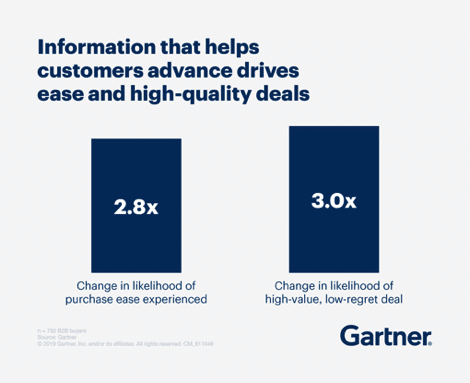
What’s interesting about visual educational content?
It changes the whole dynamic between sales reps and prospects.
Instead of the salesperson doing all the talking while the customer listens, you get something closer to a consultation. Sales representatives can share explainer videos or interactive guides that actually answer customer questions before they’re even asked. When prospects can see how something works through animated tutorials, they make decisions faster because they understand the value better.
What else is worth remembering?
- Remember to make the content multimedia.
A winning sales enablement strategy includes visual content that caters to different learning preferences and communication styles.
Here’s something every marketer learns the hard way: people consume content differently.
Some prefer listening to podcasts during their commute, others want to read a quick article between meetings, and many would rather watch a video that shows rather than tells. When you create content in multiple formats, you’re not just being thorough. You’re being smart about reaching people how they actually want to learn. This multimedia approach to your sales enablement strategy works because it matches your audience’s real-world habits instead of forcing them to adapt to your preferred format.
- Inform marketers about new materials.
Just because marketing has produced new materials doesn’t mean sales will know about it and start using it.
We have bitterly learned this ourselves. Even though we are a fairly small company, when new materials came out, not everyone would know about them.
That’s why we now have an Excel file, where all staff can see exactly what texts can be found on the website and what they are about.
3) Selecting tools and training in their use
There are lots of tools available to make a salesperson’s job easier and CRM is just one of them.
Sales enablement focuses on monitoring, testing, and training on the tools that will make salespeople’s jobs easier. Below you will find a small selection of tools that can be useful.
Several of the links provided are affiliate links. This means that if you click on the link and buy the tool, we get a small percentage of the sale. This in no way changes the price you will pay – the commission is covered by the creator of the tool.
Essential sales enablement tools for modern saleseams
When selecting sales enablement tools, it’s important to consider how they support visual content creation and management. The most effective sales enablement solutions integrate visual capabilities that help sales reps create, customize, and share visual content throughout the sales process.
Tools useful in prospecting:
LinkedIn Sales Navigator
Sales Navigator helps salespeople find and observe potential customers. This makes prospecting much more precise than using a mailing database.
LinkedIn Sales Navigator gets much more effective when you add visual outreach strategies to the mix. While everyone else is sending plain text messages, smart sales representatives are sharing visual content, explainer videos, and infographics through their social selling approaches. The difference is clear! Visual materials catch the eye immediately, leading to better buyer engagement and improved response rates.
Tool page: LinkedIn
Albacross
An app that shows you what company the people who come to your site are from.

The application analyzes the IP address of the person on the page and if the customer accesses the site from their office it can obtain information about the location. If the website is accessed from home, you will not get much information.
Tools page: Link
LiveChat
For some businesses, on-page chats can significantly increase conversions.
With on-page chats, pre-sales people can warm and qualify leads and then pass them on to the salesperson.
LiveChat functionality can be enhanced with visual elements such as embedded videos, product screenshots, or links to visual resources that help qualify leads more effectively during initial customer interactions.
Tool page: Link
WoodPecker
Cold mailing tool that is easy to use. It allows you to send mass emails from your business address. Your clients will receive messages as if you wrote them individually.
Remember! Cold email campaigns become significantly more effective when they include visual elements. Adding thumbnail images of explainer videos, infographics, or visual case studies can dramatically improve email open rates and click-through rates in sales outreach efforts.
Website of the tool: Link
Making appointments:
This is where one app reigns supreme.
Calendly
Allows you to easily schedule a meeting.
Tools page: Link

Visual Content Management Creation Tools
Beyond traditional sales tools, successful sales enablement strategies require platforms that help create, manage, and distribute visual content:
- Video creation platforms for developing explainer videos and product demos.
- Presentation software that enables interactive and visually appealing sales presentations.
- Visual content libraries that organize and categorize visual sales materials.
- Analytics tools that track engagement with visual sales content.
Content management:
Excel
This tool –allows you to group your content into different categories and let sales reps search for it in a simple and friendly way.
The tool page: no joke, everyone knows where to find it 🙂
Digital Assets Management
Here the tools include.
Adobe Experience Manager
Tool page: Link
Sitecore
Tool page: Link
Aprimo
Tools page: Link
Conversation Analysis:
Gong
This is an amazing product. Gong records and breaks down salespeople’s conversations to see what really sells.
It analyzes data on the words used in the conversation, the length of the conversation, and customer engagement. It then compares it with sales effectiveness and presents what works best in sales conversations.
Gong is only available in English at this time.
Tool page: Link
Contract Signing:
HelloSign
Until you have a signed contract, there is no sale. To speed up this last step, you can use a remote contract signing solution.
Tool page: Link
Response Templates
In sales, a lot of time is spent writing the same thing over and over again. To speed this up, you can use a tool that helps you store different response templates and customize them.
TextExpander
A tool to quickly respond to customers based on email templates.
Tool page: Link
Measuring NPS
Wootric
A simple tool to measure NPS. You can easily send surveys to customers.
Knowing the level of customer satisfaction will help you to optimize the sales process and improve customer service.
Website of the tool: Link
Database Tools
CRM
I’m a fan of Pipedrive, but it’s not the best solution for every company.
Marketing/Customer Service Automation
HubSpot
A tool best known for content marketing but it has many other options – CRM, chatbots, content management, and online courses that help with onboarding.
Website of the tool: Link
Zendesk
Zendesk has a built-in customer relationship management system that connects sales with customer support. If an existing customer asks support about new product features, it can be smoothly passed on to sales.
Tool page: Link
SalesMANAGO
Here the offering looks similar to HubSpot, but it is our Polish solution, which for some may be an advantage.
Tool page: Link
Sales Enablement
Highspot
A tool specializing in sales support. It contains everything in one – from content management through onboarding and sales force training to analytics.
Tools page: Link
Remember about training
It’s important for salespeople to gather know-how from using the tool. Often salespeople are given a new tool to use, but they are not provided with training to use it. Then it often ends up that nobody uses it.
The sales enablement team can collate the best practices on how to use CRM, prospecting tools or Sales Navigator. These can be in the form of descriptions, YouTube tutorials, or self-recorded.

We showed salespeople how to persuade store managers
to put up a rack using cartoons.
4) Analytics: sales, content and tool usage
A dedicated sales enablement manager can take a sideways look at salespeople’s activities and sales analytics and come up with suggestions for improvements.
Sales analytics:
Consider:
1) Where do sales bottlenecks occur?
At our company, we used to send customers a short form during every sales call to collect the information needed for a quote.
After analyzing the CRM, it turned out that more than 40% of projects stopped at this stage for a week or more. So we started asking questions from the form during a phone call, which accelerated the sales process.
2) Where results are worse than expected
A few months ago, we did a cleanup of the CRM, breaking down funnels into different types. One of them was a funnel coming from Referrals.
It turned out that we had an effectiveness of just over 50% for referrals. We checked why. It turned out that we were taking a nonchalant approach to these leads. “Because if someone is from a referral, they’re going to decide to work together anyway.”
We started paying more attention to referrals and since then we’ve been closing a lot more referral leads.
3) Which clients to deal with at any given time of the year
In our case, SME contracts are on average about 30-40% smaller than corporate contracts. But they close on average three times faster.
So if you want to close quickly at the end of the quarter, it makes much more sense to focus on SMEs.
With a large number of leads and a regular check of what’s going on in your CRM, you will be able to find brilliant ways to unclog the funnel and boost your results.
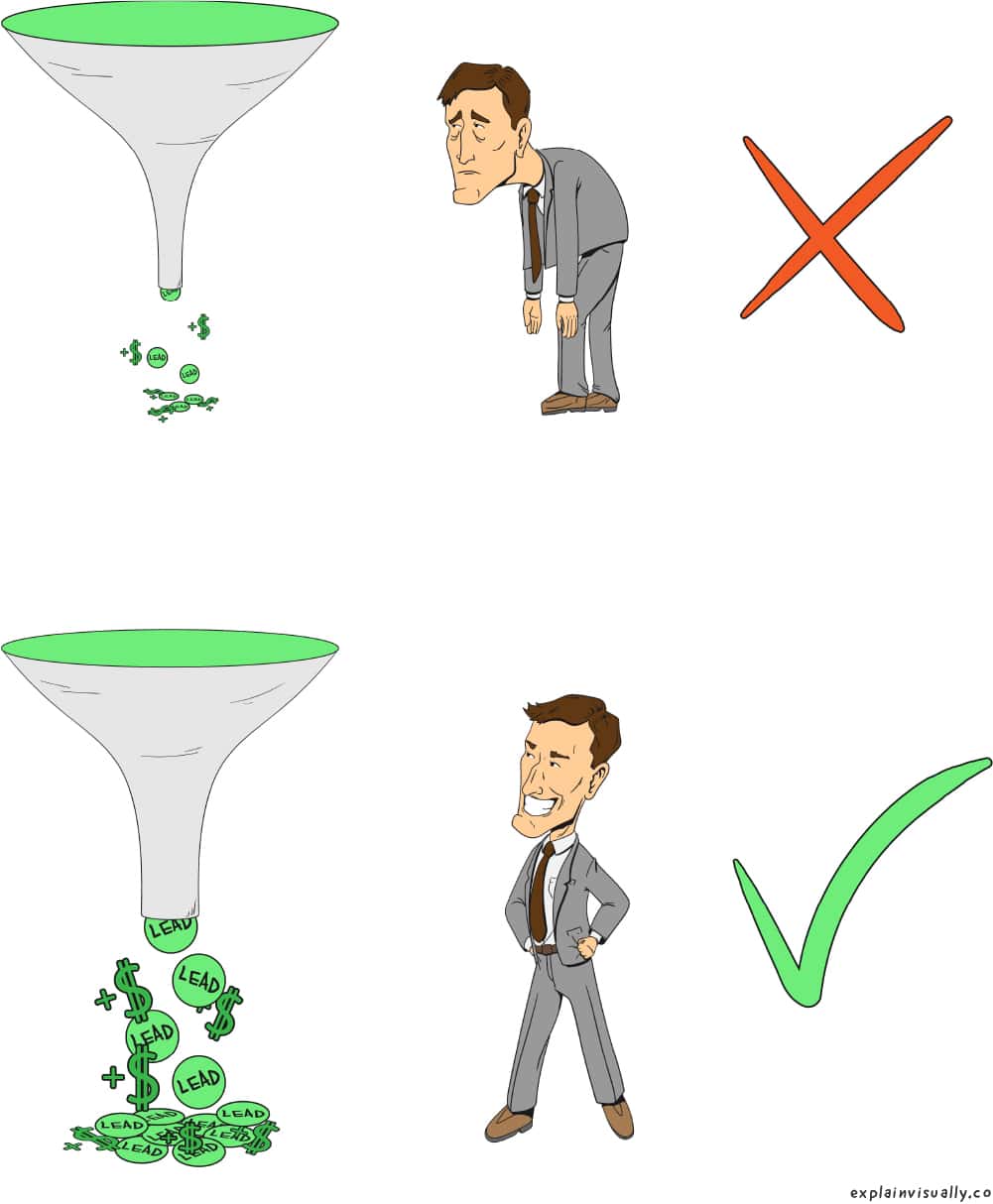
Content analytics:
The purpose of content is to take the pressure off salespeople.
If salespeople constantly have to explain the same something to customers, it might be worth creating a text, video or infographic about it.
The purpose of analytics can be to answer questions such as:
1) What content is missing?
Most often, salespeople know what questions recur in conversations with customers.
That’s why it’s a good idea for them to write these questions down. Then the sales enablement department can create content that responds to the questions most often raised.
The method of creating content based on customer questions is described well in Marcus Sheridan’s book “They Ask You Answer”.
2) What are salespeople using and not using?
Check which text are useful to salespeople and with the most popular ones consider a paid campaign to reach even more clients.
3) How much does content accelerate sales?
This is something that can be measured once you have enough salespeople and content sent. ,You can see if customers buy more after viewing your content and if they decide to buy faster.
Tool usage analytics:
1) What do salespeople waste the most time on?
Is it researching customers? Or is it answering emails?
If you can determine the answer to this question, you can start looking for tools that will save this time.
2) What are the most common problems in using current tools?
Maybe salespeople don’t fill out the CRM? Or maybe they don’t know how to select content for the customer?
The role of sales enablement is to train salespeople or provide tutorials to help deal with this.
3) Which tools are being used and which are not?
If a company has bought a new prospecting tool that no one is using, the sales enablement team can propose solutions such as additional training, changing tools or giving up.
How to implement sales enablement?
Everything sounds great, but how do you implement sales enablement in a company?
First of all, Marketing and Sales need to find a thread of agreement. Although we write here about the Sales Enablement Department, in practice it often means the Marketing Department.
What steps are worth taking?
1) Set a goal
It’s important to have a specific sales goal.
Do you want to shorten sales cycles? Increase the average contract size? Or become independent of one salesperson?
There is a lot you can do in sales enablement. A goal like this will help you decide what to focus on.
2) Divide responsibilities and tasks
The pushback between marketing and sales is almost legendary. That’s why it’s crucial to figure out who’s responsible for what, so there’s no confusion.
Especially since marketing often ventures into unfamiliar sales territory as part of this effort. However, this has the advantage of marketers better understanding the realities of salespeople’s work.
Example division of responsibility:
1) Research – marketing and partly sales
2) Content – marketing
3) Tools – marketing
4) Sales analytics – sales
Of course, within each area, there are plenty of specific tasks to be done. These tasks can be divided between marketing and sales.
Łukasz Kosuniak (ex-marketing Manager in Samsung and Microsoft) tells about a sample division of roles and cooperation between marketing and sales:
“First, both teams should know that their goal is sales and they will be held accountable for their impact on sales.
Secondly, it is worthwhile to precisely define the roles of individual teams in the sales process.
For example, if marketing’s role is to deliver leads, it’s worth defining precisely what parameters a lead should meet.
On the other hand, if a lead meets the criteria of being passed on to the sales department, salespeople should be obliged to take over the lead in a timely manner, contact the lead and describe the lead’s status in the CRM accordingly, so that it is possible, for example, to calculate the return on investment for marketing activities.
Another area of mutual support is the creation of sales content. It’s clear that marketing is responsible for organizing this process, but without the substantive involvement of salespeople, the content that marketing will produce may be ineffective.
Now that customers first read the content and then get to know the salesperson, it makes sense to ensure that the salespeople’s image is evident in the content early on in the decision-making process.
In the teams that boast good collaboration between sales and marketing, several characteristics are common:
– both teams understand the specifics of their work and know what to expect from each other (SLA of marketing and sales)
– the criteria of cooperation are clearly defined – e.g. parameters of a lead on the marketing side and a standard of servicing a lead on the sales side
– have tools that monitor the flow of data (e.g. leads) between marketing and sales
– regularly discuss the status of the lead funnel at each stage and make necessary changes (e.g. tighten or loosen qualification criteria)
– jointly define the subject matter of sales enablement content and participate in its creation and distribution
– share knowledge about customer needs and preferences – salespeople based on 1:1 communication, marketing based on surveys, research, content consumption analysis and, for example, analysis of mentions of the company or discussions in social channels.”
3) Plan the implementation and how to analyze progress
At this stage, you need a RoadMap, i.e. the steps you need to take to get to your goal (i.e. faster sales, for example).
When you’re ready to build a sales enablement program, you will need KPIs to serve as a compass that will tell you if you are going off course.
Examples of KPIs:
– Length of sales cycles
– Average deal size
– Average % of closed sales
– Number of salespeople achieving their goals.
It is also necessary to have a clear division of responsibilities between the work of the two departments.
Example of division of responsibility:
– CRM implementation – Janek, sales director;
– Creation of sales content – Marek, marketing manager;
– Training and preparation of materials – Zbyszek, our best salesperson.
If you take care of these three steps, you will significantly increase the chance that your program will be successful.
Conclusion:
Sales support is about creating an environment in which salespeople can be most effective.
In practice, this means relieving them of most tasks that are not selling.
Sales enablement itself can be broken down into four areas:
1) Gathering and organizing information about customers, competitors, and sales methods;
2) Producing content that accelerates sales;
3) Implementing tools that make the work easier; and
4) Analyzing sales, content and tools.
The marketing department in cooperation with the sales department is most often responsible for the implementation of such programs.
To implement sales enablement, you need to set:
– Goals;
– The methods for measuring progress (KPIs); and
– Scopes of responsibility.
The visual advantage in modern sales enablement
Today’s most effective sales enablement programs leverage visual content to create competitive advantages that translate into measurable business results. With 52% of B2B marketers acknowledging video as the content type yielding the highest return on investment, visual elements have become essential components of successful sales enablement initiatives.
The integration of visual content throughout your sales enablement program offers multiple benefits:
Enhanced sales training programmes that improve knowledge retention and skill development.
More engaging customer interactions that build trust and accelerate decision-making.
Streamlined sales processes that reduce cycle times and increase productivity.
Better alignment between marketing and sales teams around consistent visual messaging.
Measurable improvements in sales performance and revenue growth.
Companies that embrace visual sales enablement content position themselves to achieve long-term customer retention and sustainable competitive advantages through their sales enablement objectives. By equipping sales teams with compelling visual resources and empowering them with engaging content, these organizations create sustainable competitive advantages that drive long-term success.
Sounds unbelievable? These are the facts and potential of visual sales enablement that you can benefit from too.
If you’re looking for help in the area of producing sales enablement content, let us know.
For years we’ve been creating explainer videos, sales presentations and OnePagers that help salespeople make more appointments and close more deals.
You can see examples of our case studies here.
Our expertise in visual sales enablement content includes:
Explainer videos.
Interactive presentations that engage prospects throughout the buyer’s journey.
Visual training materials that accelerate new sales rep onboarding.
Customer success stories.
Visual content strategies.
We’re here to help you create materials that truly support your sales team’s success.

He has studied psychology at the University of Warsaw, and business at Warsaw School of Economics, as well as at University of Cambridge Judge Business School. During his studies, he has researched how people think when they are overwhelmed by information.
It has inspired him to focus on communication that explains complex subjects in a simple way. In Explain Visually, he has lead projects for companies such as IKEA, Carlsberg, Pratt & Whitney, Orange, and Pfizer. Fan of rational, science-based approach, and building marketing and sales on robust fundamentals.


